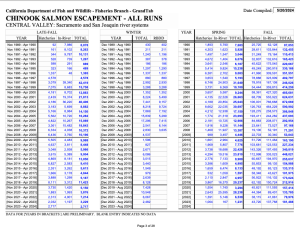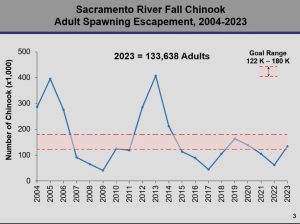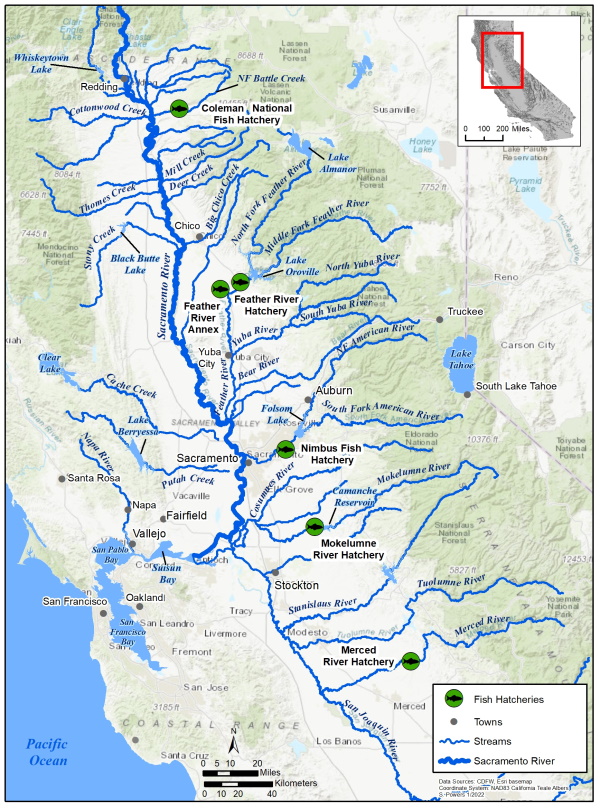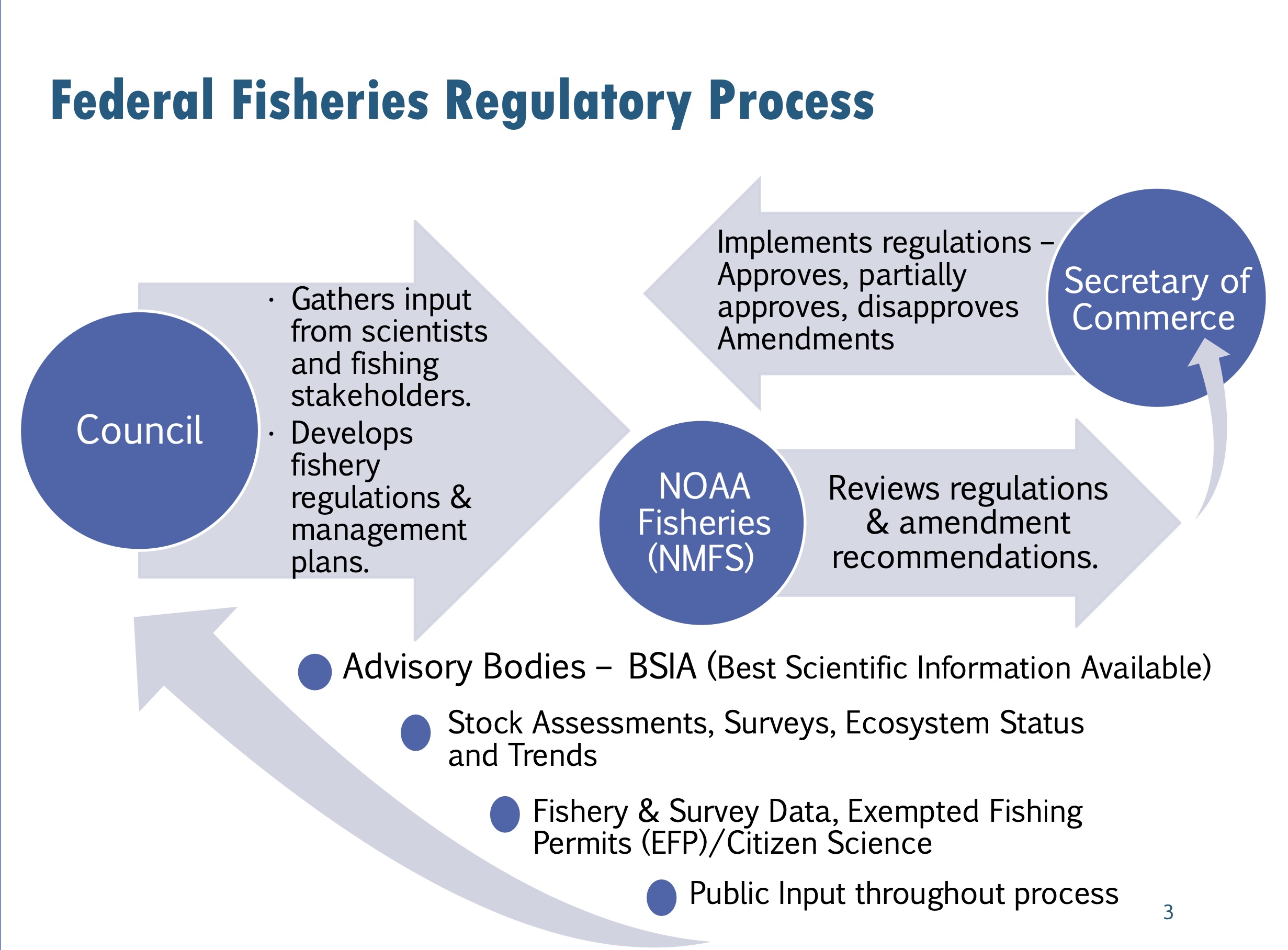Salmon: Reports and Papers
Please visit our News/Blog to find our latest posts about SALMON. Click Here
Central Valley Chinook Salmon
- 2025 Report | Sacramento River Sprint Pulse Flow Plan. Click Here to read full report. As part of the Action for the Long term Operation of the Central Valley Project and State Water Project, Reclamation would release up to 150 thousand acre-feet (TAF) in pulse flow(s) each water year, typically in the spring, to benefit Chinook salmon in the Sacramento River watershed when the pulse does not interfere with the ability to meet temperature objectives or other anticipated operations of the reservoir.
- 2024 Report | Restoring Functional Flows in Sac River – Chinook Salmon Survival in Relation to Spring Flows, Click Here
- 2023 Report | Upper Sacramento River Mainstem Fall-Run and Late Fall-Run Salmon Escapement Summary, Click Here
- The Sacramento River is a unique system that has four distinct runs of Chinook salmon. Each run is named for when the adults enter freshwater to return to spawn, not when the adults actually spawn. The chart below is a rough outline of when each run is using the river in various life stages. One of the amazing things about the Sacramento River is that there are Chinook salmon using habitat year round. — From Coleman National Hatchery

- 2024 | CDFW’s Grand Tab report from 05-20-2024. California Central Valley Chinook Escapement Database Report. GrandTab 2024.05.20.pdf file includes estimates for all four Central Valley runs of Chinook Salmon. The estimates are organized by major basin (Sacramento and San Joaquin) and then sub-basin (tributary streams and rivers) with natural spawning areas and hatcheries represented. The numbers for each run are also totaled by major basin and for the Central Valley as a whole.

- 2024 | CDFW’s Presentation on 2023 Central Valley Chinook Salmon Spawning Escapement projections by Colby Hause, CLICK HERE

- 2024 | NOAA study on Adult Upstream Salmon Migration CLICK HERE. Could California populations be more adapted to warmer temperatures? Quantifying thermal thresholds for Central Valley salmonids.
- 2024 | Sacramento Salmon Juvenile Monitoring: Preliminary estimates of passage by brood-year and run for unmarked juvenile Chinook salmon and steelhead trout captured by rotary screw traps at Red Bluff Diversion Dam on the Sacramento River. Download the Report: CLICK HERE
- 2024 | Request to Amend Endangered Species Act (ESA) and Biological Assessment associated with temporary changes to the Fall Chinook Salmon Production at the Coleman National Fish Hatchery. Temporary changes resulting from implementation of the proposed study are intended to improve success at achieving the hatchery’s annual adult contribution target of 120,000 SRFCS. CLICK HERE
- 2024 | Fry vs Smolt: Summary of Coleman NFH fall Chinook Salmon release by fish size (egg, fry, or smolt) for brood years 1945-2021. CLICK HERE
- 2023 | UC Davis: San Francisco Estuary and Watershed Science Paper: Comparing Fishery Impacts and Maturation Schedules of Hatchery-Origin vs. Natural-Origin Fish from a Threatened Chinook Salmon Stock: Central Valley Spring-run Chinook (CVSC) are listed as threatened under the California and federal Endangered Species Acts, but how ocean fisheries affect CVSC is not routinely monitored or managed, largely because of data limitations CLICK HERE
- 2023 | CDFW’s GrantTab – Central Valley Chinook Escapement Database Report CLICK HERE
The Sacramento – San Joaquin River system in California’s Central Valley is the principal producer of Chinook Salmon, caught in California’s ocean fisheries and contributes appreciably to Chinook Salmon harvest off the coasts of Oregon and Washington. This system also supports one of the largest river sport fisheries for Chinook Salmon on the Pacific Coast in the Sacramento River. Chinook Salmon in the Central Valley are comprised of four runs: late-fall, winter, spring, and fall runs. Run designation is based primarily on the season during which adult Chinook returning from the Pacific Ocean enter fresh water on their upstream spawning migration. Currently, both the ocean and river fisheries in California are managed to focus exploitation on Central Valley fall-run Chinook Salmon. The fisheries are largely possible as the result of a high level of hatchery production, both for mitigation and population supplementation. There is a small sport fishery for late-fall-run Chinook Salmon in the Sacramento River. Sacramento River winter-run Chinook are listed as endangered under both the California Endangered Species Act (CESA) and U.S. Endangered Species Act (ESA). Central Valley spring-run Chinook Salmon are listed as threatened under both the CESA and the ESA. Given their protected status, fisheries management of Chinook Salmon in California is designed to avoid incidental harvest of Central Valley winter-run and spring-run Chinook Salmon.
- 2023 | Escapement Estimation Methods and Grilse Determination Sacramento River Fall Chinook from CDFW – Fisheries Branch, Information compiled by Jason Azat. The information contained in this document is current as of May 2023. To read, click here
- 2022 | Preliminary Summary for Estimated Adult Pre-Spawn Mortality for all 2021 Central Valley Chinook Salmon Runs Due to Excessive Temperatures in the Sacramento Basin. California Department of Fish and Wildlife, May 2022. Click Here to read
- 2022 | Are There Too Many Salmon in the North Pacific Ocean? Click Here. From the North Pacific Anadromous Fish Commission newsletter 51, Jan. 2022. Overabundance of salmon, combined with effects of recent marine heat waves, may have been responsible for unexpectedly low returns of all five species of Pacific salmon across the North Pacific in 2020
- 2022 | Sacramento Fall Run Escapement data chart: Escapement, harvest, and production data and preliminary estimated restoration coals for chinook salmon based on doubling of natural production, CLICK HERE to view.
- 2022 | Central Valley Hatchery Salmon Production Is Being Wasted: A Tale of Two Hatchery Salmon Smolt Release Groups, Click Here to read
- 2022 | Trends in Chinook salmon spawner abundance and total run size highlight linkages between life history, geography and decline. To understand trends in Chinook salmon production, and how they are related to life history, this study compiled time series data from the Fraser River to the Sacramento River on total run size (pre-fishery abundance) and escapement (post-fishery spawner abundance) and fit time series models to estimate trends across this bioregion. Credit: by William Atlas published Sept. 2, 2022, revised March 2023 from the Wild Salmon Center, Portland, Ore. Click here to read PDF
- 2021 | Pilot Evaluation of Barging Hatchery – Origin Juvenile Salmon from the California Central Valley through the Bay-Delta. Click Here to read
- 2021 | Central Valley Constant Fractional Marking/Tagging and Recovery Programs from CALFISH.ORG
The Central Valley Constant Fractional Marking/Tagging Program (CFM) was initiated in the spring of 2007 to estimate the relative contribution of hatchery production to fishery harvest and spawner escapement, and to evaluate various release strategies employed in the Central Valley.
- The CFM Marking/Tagging Program is implemented at the Coleman National Fish Hatchery, Feather River Fish Hatchery, Nimbus Fish Hatchery, Mokelumne River Fish Hatchery, and the Merced River Hatchery. These hatcheries produce and release juvenile Chinook salmon and steelhead to mitigate for lost habitat and declining anadromous fish production. Read more documents, click on link: Anadromous Salmonid Population Monitoring Documents
- Read the Recovery of Coded-Wire Tags from Chinook Salmon in California’s Central Valley Escapement, Inland Harvest, and Ocean Harvest yearly reports, from CalFish.org click links below:
• CFM Report – 2021 Marking Season
• CFM Report – 2020 Marking Season
• CFM Report – 2019 Marking Season
• CFM Report – 2018 Marking Season
• CFM Report – 2017 Marking Season
• CFM Report – 2016 Marking Season
• CFM Report – 2015 Marking Season
• CFM Report – 2014 Marking Season
• CFM Report – 2013 Marking Season
• CFM Report – 2012 Marking Season
• CFM Report – 2011 Marking Season
• CFM Report – 2010 Marking Season
• CFM Report – 2009 Marking Season
- 2020 | RELEASING SALMON: Trucking smolts versus imprinting in the Sacramento Index: Recovery of Coded-Wire Tags from Chinook Salmon in California’s Central Valley Escapement, Inland Harvest, and Ocean Harvest in 2017, read full report CLICK HERE
- 2019 | Recovery of Coded-Wire Tags from Chinook Salmon in California’s Central Valley Escapement, Inland Harvest and Ocean Harvest in 2019 Report: Click Here to Read
- 2019 | Eight Decades of Hatchery Salmon: Releases in California’s Central Valley. Factors influencing straying and resilience. Click Here to read. Fisheries Magazine, Vol. 44, No. 9, Sept. 2019
- 2019 | Central Valley Salmon And Steelhead Monitoring Programs, Click Here to read more
- 2018 | Fishery collapse, recovery, and the cryptic decline of wild salmon on a major California river. Identifying temporal trends in the relative contribution of hatchery- versus wild-spawned salmon is vital for assessing the status and resiliency of wild salmon populations Click Here
- 2017 | The Nigiri Project: Managed floodplains for salmon restoration in the Yolo Bypass. The Yolo Bypass is adjacent to the Sacramento River. This is the Project outline draft from Nov. 9, 2017. The research is a collaborative project among the UC Davis Center for Watershed Sciences, the California Department of Water Resources and CalTrout. Click Here to read more.
- 2017 | NOAA Report on the Evaluation of alternative marking/tagging systems for hatchery produced California Fall-Run Chinook Salmon: https://repository.library.noaa.gov/view/noaa/14328
- 2014 | Evaluation of a single nucleotide polymorphism baseline for genetic stock identification of Chinook Salmon in the California Current large marine ecosystem by NOAA, click here.
- 2013 | Sacramento River County Atlas, Keswick to Verona – Shasta to Yolo County. Authors by the Geographical Information Center. Publisher: Sacramento River Conservation Area Forum, 2013. This atlas (Click Here to download) is composed of 7 maps, one for each county, which depict riparian vegetation, private and public conservation lands and river miles. Download other maps from the website, Click Here
- 2012 | Central Valley Chinook Salmon In-River Escapement Monitoring Plan – Fisheries Branch, Jan. 2012. Click Here to Read
- 2011 | Click Here to read Review of the Central Valley Angler Survey by West Inc., Environmental & Statistical Consultants. Summary: Inland sport harvest of Chinook salmon in California’s Central Valley (CV) streams comprises a significant proportion of the total escapement. The CV angler harvest survey, reinitiated in 2007, is a long-term monitoring program designed to develop annual estimates of total angler effort and in-river harvest of sport fish from the Sacramento River and major tributaries. In addition to Chinook salmon, the survey includes a number of other species considered to have recreational value.
- 1998 | Historical Abundance and Decline of Chinook Salmon in the Central Valley Region of California. North American Journal of Fisheries Management 18. American Fisheries Society 1998. Authors: Ronald Yoshiyama (UC Davis), Frank Fisher (CDFW), and Peter Moyle (UC Davis). Click Here to Read
- 1920 | A historical (1920s) and statistical review of the Sacramento-San Joaquin Salmon Fishery. Click Here. Division of Fish and Game of California Fish Bulletin No. 17 | Sacramento-San Joaquin Salmon (Oncorhynchus Tschawytscha) Fishery of California, by G. H. Clark, Bureau of Commercial Fisheries.
Klamath-Trinity Chinook Salmon
- Klamath River Outmigrant Monitoring Update — June 28, 2024, Click Here
- Klamath River Basin Fall Chinook Salmon Spawner Escapement, In-river Harvest and Run-size Estimates, 1978-2023, CLICK HERE
- 2023 | Klamath and Trinity River Reports from the Fish & Game Commission, 2023. Click Here to read full report.
- 2022 | PFMC Klamath Salmon data sheets: Page 1: Estimates of Yurok and Hoopa Valley reservation Indian gillnet Chinook harvest in numbers of fish, CLICK HERE; Page 2: Summary of Klamath River fall Chinook salmon estimates in numbers of adults and jacks, CLICK HERE.
- 1930 | CADF&G/Fish Bulletin No. 34: Salmon of the Klamath River, CA by John O. Snyder, Stanford University. A report of the 1930 Catch of King Salmon in the Klamath River. The Salmon and the Fishery of the Klamath River. Click Here to read.
ESA LISTING OF SALMON
NOAA Fisheries, also known as the National Marine Fisheries Service, is responsible for the management, conservation, and protection of living marine resources within about 200 miles of the U.S. coast.
- 2021 | Salmon Species listed under the Endangered Species Act (ESA Listing) by NMFS, Click Here
Science Papers | Chinook Salmon
- 2023-2022 | Trends in Chinook salmon spawner abundance and total run size highlight linkages between life history, geography and decline. To understand trends in Chinook salmon production, and how they are related to life history, this study compiled time series data from the Fraser River to the Sacramento River on total run size (pre-fishery abundance) and escapement (post-fishery spawner abundance) and fit time series models to estimate trends across this bioregion. Credit: by William Atlas published Sept. 2, 2022, revised March 2023 from the Wild Salmon Center, Portland, Ore. Click here to read PDF
- 2019 | Identifying hidden biocomplexity and genomic diversity in Chinook salmon, an imperiled species with a history of anthropogenic influence. Click Here to read full paper
Water Flow | River Changes | Challenges
- NOAA Central Valley Temperature Mapping and Prediction: This website is the public interface for modeled and observed water temperature and flow data for the Sacramento River associated with Shasta Reservoir, Shasta and Keswick Dam operations, and meteorological conditions. A primary input and assumption of the models is based on the operational conditions forecasted for Shasta and Keswick reservoirs generated by USBR. These forecasts are updated over time and composed of different scenarios of hydrological (dry or wet) and meteorological (warm or cool) conditions. Model outputs from each scenario are displayed. Click Here for Gage Stations website.
- 2022 | Pit River Bridge Summary: The Pit River Bridge is the only interstate highway bridge owned by the federal government in the entire United States. The 80-year old bridge carries Interstate 5, the Union Pacific Railroad and Amtrak, over Shasta Lake north of Redding, California. The federal government wishes to relinquish ownership of the bridge beyond the year 2040. The United States Bureau of Reclamation (USBR) and Federal Highway Administration (FHWA), along with the California Department of Transportation (Caltrans) are taking the lead on replacing or rehabilitating the highway portion of the bridge before the joint agreement to use and maintain the bridge expires in 2040. Funding options are being pursued to complete needed studies. Click here to read more.
- 2019-2020 | The Nigiri Project 2017 and 2018: California’s native fish populations are in dramatic decline. Before the Central Valley was developed, leveed and drained, food webs produced on over four million acres of seasonally inundated floodplain supported robust fish and wildlife populations. Over the last century and a half, development—primarily for agriculture and flood control—has cut off 95% of wetlands from Central Valley rivers, effectively starving river ecosystems of the foundation of the aquatic food web: the solar energy captured by plants and algae on floodplains. Click on links below:
A) Fish Food 2019; B) Flood Plan; C) Divide and Conquer; Flood Study Group Communications Framework
- 2012 | Fish Passage Improvement Project at the Red Bluff Diversion Dam (RBDD) from Sept. 2012
Click Here to Read
- 2011 | Buoyancy regulation by hatchery and wild Coho Salmon during the transition from freshwater to marine environments. American Fisheries Society from January 9, 2011, Vol. 137, Issue 3, 2008, Pages 860-868, Click Here
- 2009 | Historical channel changes in the lower Yuba and Feather Rivers
Click Here to Read
- 2008 | Flow Recommendations to the State Water Resources Control Board from May 22, 2008. Click Here to Read
- 1992 | Historical and Present Distribution of Chinook Salmon in the Central Valley Drainage of California. Fish Bulletin 179, Vol. One, Click Here
Predation Studies
- 1981 | Predation: The Impact of Squawfish on Salmonid Populations, a review published by the North American Journal of Fisheries Management, Click Here
- 2019 | Delta smolt survival: Georgiana Slough, published by Fish Guidance from Feb. 22, 2019, Click Here
Hatcheries & Salmon Studies
- Govenor Newsom’s upgrades to Calif Hatcheries Plan, Click Here
- Mad River Hatchery Upgrades Report from CDFW, Click Here. McMillon services who conducted the report, click here
- There are fish hatcheries run by the Federal Government and there are fish hatcheries run by the State of California. The federal government operates two national fish hatcheries: the Coleman National Fish Hatchery and the Livingston Stone National Fish Hatchery, which are part of the U.S. Fish and Wildlife Service’s National Fish Hatchery System
- 2024 | Hatchery Fish vs Wild Fish from Oregon Anglers Alliance, CLICK HERE
- 2024 | Fry vs Smolt: Summary of Coleman NFH fall Chinook Salmon release by fish size (egg, fry, or smolt) for brood years 1945-2021. CLICK HERE
- 2024 | Oregon Anglers Alliance report on the benefits of salmon hatcheries in PNW. A) Hatcheries produce 70% of captured salmon; B) Improving recreational fishing is a good investment; C) Hatcheries can help compensate for more than 40% of salmon spawning habitat that has been lost. Click Here to read the report page 1, page 2, page 3.
- 2019 | Bigger doesn’t mean better for hatchery-released salmon, Click Here to read more
- 2017 | NOAA Report on the Evaluation of alternative marking/tagging systems for hatchery produced California Fall-Run Chinook Salmon: https://repository.library.noaa.gov/view/noaa/14328
- 2012 | California Hatchery – Review Report prepared by the California Hatchery Scientific Review Group Click Here
|















